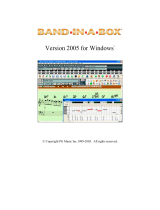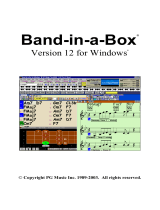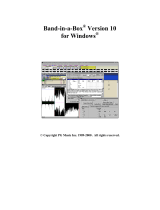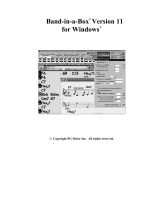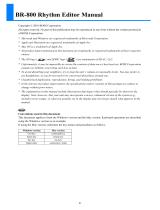Page is loading ...

®
®
Version 12 for Macintosh
®
OS X
Copyright 1989-2004 PG Music Inc. All rights reserved.

PG Music Inc. License Agreement 2
PG Music Inc. License Agreement
CAREFULLY READ THE FOLLOWING TERMS AND CONDITIONS BEFORE COMPLETING
THE INSTALLATION OF THIS SOFTWARE. USAGE OF THE SOFTWARE INDICATES
YOUR ACCEPTANCE OF THE FOLLOWING TERMS AND CONDITIONS.
LICENSE
A. The program may only be used on a single machine.
B. You may transfer the program and license to another party if the other party agrees to
accept the terms of this Agreement. If you transfer the program, you must either transfer
all copies, whether in printed or machine readable form, to the same party, or, destroy all
copies not transferred. This includes all modifications and/or portions of the program
merged into other programs.
C. You may receive the program in more than one media. Regardless of the type or size of
media you receive, you may install or use the media on a single machine.
The program (including any images, “applets,” photographs, animations, video, audio, music, and
text incorporated into the program) is owned by PG Music Inc. or its suppliers, and is protected by
international copyright laws and international treaty provisions.
You may not use, copy, or transfer the program, or any copy, modification or merged portion of the
program, in whole or in part, except as expressly provided for in this license. If you transfer
possession of any copy, modification or merged portion of the program to another party, your license
is automatically terminated.
LIMITATION OF REMEDIES
PG Music Inc.'s entire liability and your exclusive remedy shall be:
A. The replacement of any media not meeting PG Music Inc.'s “Limited Warranty,” which
are returned to PG Music Inc., or an authorized PG Music Inc. dealer, with a copy of your
receipt.
B. If PG Music Inc. or the authorized dealer is unable to deliver replacement media that is
free of defects in materials or workmanship, you may terminate this agreement, and your
money will be refunded.
In no event will PG Music Inc. be liable to you for any damages, including but not limited to lost
profits, lost savings, or other incidental or consequential damages arising out of the use or the
inability to use such program, even if PG Music Inc. or an authorized PG Music Inc. dealer has been
advised of the possibility of such damages, or for any claim by any other party.
TRADEMARKS
Band-in-a-Box®, PG Music®, and PowerTracks Pro® are the registered trademarks of PG Music
Inc. in the United States, Canada, and other countries. Microsoft® and Windows® are either
registered trademarks or trademarks of Microsoft Corporation in the United States and/or other
countries. Apple®, the Apple logo, iMac®, Macintosh®, Mac®, Panther™, Power Mac®,
QuickTime® and True Type® are trademarks of Apple Computer, Inc., registered in the U.S. and
other countries. Other brands and their products are trademarks or registered trademarks of their
respective holders and should be noted as such.
PATENTS
Band-in-a-Box is protected under US Patent 5990407.
Printed in Canada

Table of Contents 3
Table of Contents
PG Music Inc. License Agreement 2
Chapter 1: Introduction 6
Chapter 2: QuickStart Tutorial 8
Step 1 – Typing in the Chords...............................................................8
Step 2 – Choosing a Style....................................................................11
Step 3 – Play your song!......................................................................12
Chapter 3: Summary of New Features 14
Chapter 4: Guided Tour of Band-in-a-Box 25
Loading and Playing Songs .................................................................25
View and Print Notation......................................................................29
Play the Jukebox..................................................................................31
Automatic Songs - “The Melodist”......................................................32
Make Your Own Songs........................................................................34
Have Fun!............................................................................................39
Chapter 5: The Main Screen 40
Overview of the Main Screen..............................................................40
Synth Window / Piano Keyboard ........................................................ 42
Tool Bar...............................................................................................45
Title Window....................................................................................... 46
Chordsheet Area .................................................................................. 48
Chapter 6: Band-in-a-Box PowerGuide 50
Song Settings....................................................................................... 50
The Chordsheet.................................................................................... 55

Table of Contents 4
Chord Preview/Builder.........................................................................66
MIDI file “Chord Wizard” ...................................................................68
Applying Styles....................................................................................70
Playing, Pausing, and Stopping Songs .................................................72
Changing Volume, Panning, Reverb, Chorus, Bank ............................74
Saving Songs........................................................................................74
Other Edit Functions.............................................................................76
More Preferences – Preferences 2........................................................81
MIDI Setup...........................................................................................85
The JukeBox.........................................................................................90
Chapter 7: Notation and Printing 93
Notation................................................................................................93
Printing...............................................................................................104
Chapter 8: Automatic Music Features 107
Automatic Songs - “The Melodist”....................................................107
Automatic Solo Generation – “The Soloist” ......................................115
Automatic Guitar Chord Solos – “The Guitarist”...............................120
Chapter 9: Recording Tracks 125
Real Time Recording..........................................................................125
Step Edit Notes...................................................................................127
Entering Notes Manually in the Notation Window............................128
Recording with the Wizard Feature....................................................128
Importing Pre-Recorded MIDI Data...................................................129
Record using The Melodist ................................................................130
Additional Options for Melody/Soloist Track....................................131
Chapter 10: Built-in Drums 139
Animated Drum Kit............................................................................139
Drum Kit Main Window ....................................................................142

5
Chapter 11: User Programmable Functions 144
The StyleMaker
...............................................................................144
The Harmony Maker.......................................................................... 167
The Soloist Maker..............................................................................173
The Melodist Maker .......................................................................... 176
The Guitarist Maker........................................................................... 181
Chapter 12: Tutors and Wizards 186
MIDI File Chord Wizard................................................................... 186
The Guitarist...................................................................................... 194
Guitar Tutor....................................................................................... 198
Chord Substitution Wizard ................................................................ 201
Chord Builder ....................................................................................205
Chapter 13: CoreMIDI and QuickTime OS X 206
CoreMIDI and QuickTime OS X Tutorial.........................................206
Chapter 14: Reference 213
Band-in-a-Box Menu Descriptions.................................................... 213
Song Menu......................................................................................... 226
GS Menu............................................................................................249
Keystroke Commands – “Hot Keys”................................................. 254
PG Music Inc. 258
Index 259
Registration Form 267
How to Register................................................................................. 267

Chapter 1: Introduction 6
Chapter 1: Introduction
The latest version of Band-in-a-Box for Macintosh is
built for OS X, and adds many new features! This
exciting new version of Band-in-a-Box for Macintosh
runs “Native” in OS X Jaguar or Panther (version
10.2 or higher recommended) and includes many new
and enhanced features.
Band-in-a-Box version 12 is fully Mac OS X carbonized. We have a huge
number of new and improved Styles, Soloist, Harmonies, and Song Demos,
making your Band-in-a-Box program sound better than ever! Program
operations are much faster, including up to 3 times faster notation redraws, song,
and soloing generation. Playback timing is improved and rock-solid with Mac
OS X. You can export your Band-in-a-Box files and import them into Apple’s
GarageBand program for further processing. And we include a great
QuickTime video tutorial, showing you all the newest features in version 12!
The styles have been greatly enhanced – we’ve edited the existing styles, and
made many more styles using the newest features. This automatically makes
your existing songs sound better! New Soloists, Melodists and Harmonies are
now included, making this the best-sounding Band-in-a-Box ever!
The user interface has been enhanced with improved menus, and other
enhancements, giving Band-in-a-Box a much better look in the OS X
environment. Improved OS X 128X128 “high resolution” program and file
icons are also included with this upgrade to enhance the user experience.
Timing has been improved to microsecond accuracy for tighter playback.
MIDI support for Band-in-a-Box 12 for Macintosh now includes CoreMIDI
(for support of external MIDI devices) as well as improved support for
QuickTime Music synthesizers, making it work and sound much better in OS
X. Additional MIDI driver enhancements allow users with controller keyboards
such as the M-Audio Oxygen 8, or the Edirol PCR-1 to play thru the QuickTime
Music synthesizer from their MIDI keyboard.
Other enhanced features include: odd-time signature support (7/8, 11/8 etc.),
maximum number of Soloists increased from 256 to 1024, count-in types now
include choice of drum pattern or regular count-in, addition of “low root
harmony” setting to Harmony Edit dialog, “Strauss-in-a-Box” to automatically
transform any 4/4 song to a Waltz 3/4 feel, “De-Strauss” to transform any song
with a 3/4 time signature to a 4/4 feel, StylePicker Dialog enhancements, bass
player plays better “5ths” over some Jazz chords, support for audio and video
memos for songs , options to set the note density in the Soloist and much
more.

Chapter 1: Introduction 7
And much more …
People familiar with the previous versions of Band-in-a-Box will be pleased to
know that we have kept the same functionality of our previous releases. The
new features are optional and don't interfere with familiar methods of using the
program. All songs, styles etc. are completely compatible with previous
versions, so that you can upgrade without losing any of your existing work.

Chapter 2: QuickStart Tutorial 8
Chapter 2: QuickStart Tutorial
Creating music with Band-in-a-Box is as easy as 1-2-3! In this tutorial, you’ll
see just how easy it is to get Band-in-a-Box making music for you.
Step 1 – Typing in the Chords
There are numerous ways of entering chords into Band-in-a-Box. We’ll discuss
five fast ways of entering chords:
1. Using the Computer Keyboard
2. Playing directly on a MIDI Controller Keyboard
3. Using the Chord Builder
4. Importing Chords from a MIDI file
5. Loading an Existing Band-in-a-Box Format Song
On the main screen of the program, you’ll see an area called the chordsheet.
Band-in-a-Box main screen showing chordsheet.
Each of the numbered cells on the chordsheet represents a bar. In this example,
you can see that there is an F6 chord in the first bar of this song. Similarly, one
row down, you can see an F6 chord in bar 5, and later in the song, a G7 in bar 7.

Chapter 2: QuickStart Tutorial 9
Notice the box in the first half of bar 1. This is the highlight cell, and it
represents the bar you are currently working on. You can move the highlight
cell around using the cursor keys, or select a specific bar using the mouse.
Enter Chords Using the Computer Keyboard
To enter a specific chord, move the highlight cell to where you want to place the
chord. For example, if you wanted to add (or change) a chord in bar 20, you
would highlight bar 20 on the chordsheet. Next, type in your chords. If you
want an F7 at bar 2, type F and 7 on your keyboard and press return. Notice
that when you use the return key, the highlight cell moves to the second half of
the bar. You could then enter another chord at beat 3. Chords are commonly
typed using standard chord symbols (like C or Fm7 or Bb7 or Bb13#9/E), but
you can enter them in any of the supported chord symbol display formats like
Roman Numerals, Nashville Notation, and Solfeggio.
Enter Chords Using a MIDI Controller Keyboard
If you have a MIDI controller keyboard, you can use it to enter chords into
Band-in-a-Box. First, you must make sure that your cables are properly
connected and you have the correct input drivers selected.
If you play a chord on your MIDI keyboard, and then press Ctrl+Return, the
chord will be entered into the chordsheet at the current highlight cell position.
Enter Chords Using the Chord Builder
Press the Chord Builder button. This opens the Chord Builder dialog
with a list of chord roots and their extensions.
Chord Builder Dialog
To enter a chord at the current bar, select the chord root from the left pane, and
then the extension on the right pane. Pressing [Enter Chord ___] enters the
chord and advances the highlight cell to the next half bar.
Import Chords from a MIDI File
You can have Band-in-a-Box import chords from an existing MIDI file. Choose
File | Import Chords from MIDI File on the File menu, or use the keystrokes
Ctrl+Option+I, to open the Chord Wizard dialog.

Chapter 2: QuickStart Tutorial 10
Chord Wizard Dialog
When the Chord Wizard dialog opens, press the [Open (Change)…] button to
choose the MIDI file that you want Band-in-a-Box to interpret the chords from.
To help Band-in-a-Box interpret the chords better, you can choose a preset for
the song. Choose from among such genres as Pop, Rock, or Jazz Standard.
Loading an existing Band-in-a-Box format song
Press the [song] button. The first time you use this button, Band-
in-a-Box will offer to build a song list for you. We’ve included many demo
songs for you to use, and they are listed in the song list.
You could also load a pre-existing song by using the File | Open song… menu
item, or by pressing the F3 function key, which will launch the familiar
Macintosh file dialog. Note that most songs will automatically load a “Style,”
which we’ll learn about in the next section.
Going to the next step …
Now that you have chords on your chordsheet, you are ready to move on to step
number two.

Chapter 2: QuickStart Tutorial 11
Step 2 – Choosing a Style
Band-in-a-Box creates backing arrangements based on the chords you type in,
applied to a particular Style.
What’s a Style?
A style is a set of rules that determine how Band-in-a-Box creates music using
your chords. By adjusting the rules, we have created hundreds of styles that are
appropriate for everything from Country to Bebop. Some style examples would
be Jazz Swing, Blues Shuffle, Hip Hop, Country 4/4, Pop Ballad, Waltz and
Medium Rock to name just a few. If you don’t find a pre-made style that suits
your tastes, create one from scratch using the StyleMaker. Making custom
styles with the StyleMaker is explained in detail in the full documentation.
Four Fast ways to Open a Style
Method 1: From Disk
To open a user style from disk, you can just type the F9 key. You will be
presented with the familiar Macintosh file dialog from which you can select a
specific style from the Styles folder.
Method 2: The StylePicker
You can use the StylePicker window to select your style.
Select the [Style] button above the chordsheet, or type
Ctrl+F9 on your computer keyboard.
The StylePicker

Chapter 2: QuickStart Tutorial 12
Selecting a Style using the StylePicker.
This window shows styles listed by Styles Set number, and by genre. Select a
Set or genre from the left pane, and choose the specific style on the right pane.
There are memos and examples for each of the styles. Styles with a similar feel
and tempo range to the current selection (prototype) are marked with an (*)
asterisk. These styles are possible substitutes for the prototype. Styles marked
with a (^) caret symbol are similar in feel but have a different tempo range. The
style of your song can be changed at any bar by pressing the F5 key to launch
the Edit Bar Settings dialog.
Method 3: Favorites
Styles that you’ve used previously show up in the Favorite Styles dialog.
Choose this from the menu User | Load Favorite Styles… or type Shift+F9 on
your computer keyboard, or click on the [f] button to the left of the [.STY]
StylePicker button. You can choose to save a Favorites set for use later. You
can also load a set of favorite styles this way.
Method 4: Quick Pick
You can choose from among the
24 “built-in” styles. This list
provides a quick way to choose
from among the most popular
music genres.
Step 3 – Play your song!
We’ve entered chords on the chordsheet and chosen a style. Now it’s time to
play the song! First we need to tell Band-in-a-Box how long our song is, how

Chapter 2: QuickStart Tutorial 13
many times we want the program to play through the chords, in what key and
how fast.
Framing the Song
To tell Band-in-a-Box where the start and end of the song is, we look at the
middle of the Band-in-a-Box main screen.
Locate the framing settings, there are three of them. The numbers (1 -32) in
brackets are the bar numbers for the beginning and the end of the Chorus. The
number 3 to the right of the brackets is the number of times the Chorus repeats.
In the example above, the Chorus starts at bar 1, ends on bar 32, and is going to
play 3 times. You can change these settings to play more choruses, or make the
Chorus start later, for example in the case where you want an intro to play.
Setting the Key
In the example above, the key is set to C. However, you can set this to any key.
In our first view of the chordsheet, the blues song was in the key of F. If you do
change the key, Band-in-a-Box will offer to transpose the chordsheet for you.
This is especially useful when loading in new songs and transposing them to
other keys. If you’ve entered a progression that you intend for a particular key,
and then choose the key afterward, you should say no when asked to transpose
the chordsheet.
Setting the Tempo
If you know the tempo value of your song, you can enter it in the tempo box.
The song example above has a tempo of 120. There is an even faster way to
enter a tempo. Locate the minus key [-] and the equals key [=] in the number
row of your computer keyboard, they are usually next to each other. If you tap
the [-] key 4 times at your tempo, Band-in-a-Box will set the tempo
automatically for you. If you tap the [=] key four times, Band-in-a-Box will set
the tempo and begin song playback!
Press Play
When you’re ready, just press the [Play] button or the F4 function key and
Band-in-a-Box will immediately generate and play a professional arrangement
of your song using the settings and the style you selected.
Having more fun with Band-in-a-Box.
That’s all there is to quickly creating music with Band-in-a-Box. There are also
many powerful features and user settings for you to discover. Have fun making
music with Band-in-a-Box!

Chapter 3: Summary of New Features 14
Chapter 3: Summary of New Features
New Features in Band-in-a-Box Version 12 for Macintosh OS X…
All New 32-bit PPC Carbonized Engine.
Previous versions of Band-in-a-Box were 68K code, which required translation
by the processor to operate on newer Macs. The new program is rebuilt with a
32-bit-clean carbonized PPC engine, so that it runs natively in OS X. Program
operations are much faster, including up to 3 times faster notation redraws, song
and soloing generation. Playback timing is improved and rock-solid with Mac
OS X.
Odd-Time Signature Support.
Previous versions of Band-in-a-Box supported only X/4 time signatures, but
now we’ve added support for odd-time signatures like 9/8, 11/8, 13/16, 19/16,
etc. The count-in and the style plays in the odd-time signature feel, and you can
change time signatures during the song.
Note: The notation window still displays/edits these odd-time signatures in 4/4, but
the styles all play/sound correctly.

Chapter 3: Summary of New Features 15
Example of odd-time signature support:
Load in a demo song like Songs: 11_8_Pop.MGU.
This loads in the “11/8 Pop” Style.
When you press Play, you’ll hear a count-in in 11/8 time.
The 11/8 time signature is stored within the style, so you can switch at any bar
to a 4/4 style, and the song will change time signatures easily. Also, if you
change from a 4/4 style to an 11/8 style, the Melody will still stay nicely in time
with the bars.
With the pro version we include 5/4, 7/8, 24/16, and 11/8 time signatures. There
are 20 more available on the “About Time” Styles disk #38. There is also an
“About Time Video” available that demonstrates using odd time signatures in
BB, and how to “count” in odd-time signature styles.
Maximum Number of Soloists increased
Maximum Number of Soloists increased to 1,024 (from 256), and new
Soloists added. The previous limit of soloists was 256, and we had already
defined 253 of them! We’ve now increased this limit to 1,024, and have added
new soloists. The default Soloist file for the OS X version of Band-in-a-Box is
now called Default_OS X.SOL. (the OS9 version is called DEFAULT.SOL)

Chapter 3: Summary of New Features 16
New Count-In Options
“Count-in” can be Drum Patterns instead of “1-2-1234.” There is a new
option in Preferences to select count-in type. You can specify to have Band-in-
a-Box play 2 bars of a drum pattern instead of the count-in. You may prefer
hearing the drum beat to a simple count-in, since it provides more information
about the upcoming groove. If you’re playing with Band-in-a-Box live on a
“dance floor,” this setting is a great way to avoid “dead air” between songs, and
keep the drumbeat going. Includes options to have “a” or “b” drum fills or
patterns play for the 2 bars.
To set this, choose Prefs | CountIn, and set Lead-in Type to one of “b” substyle
fills/ “a” substyle fills/ or fill-pattern or pattern-pattern combinations.
Harmony – Low Root Feature.
The Harmony Edit dialog now has settings for “low root harmony” which adds a
voice that plays the root of the chord. This is useful for a cappella or baritone
sax harmonies, where the lowest voice is playing the bass roots. You can set the
low-high range. The root played will always be at least one octave from the
melody note (assuming it can still be inside the set low/high range). We include
many harmonies that are preset to use this low root harmony feature. They are
in the range starting at harmony #153.
The Harmony Edit dialog now has settings for “low root harmony” which adds a
voice that plays the root of the chord. This is useful for a cappella harmonies
where the lowest voice is playing the bass roots. You can set the low-high
range. The root played will always be at least one octave from the melody note
(assuming it can still be inside the set low-high range).
You can edit any harmony to add a low root harmony by pressing Edit Harmony
(on the Harmony selection dialog), and then selecting “Low Root” and then
inputting the range of acceptable notes for the low root voice, and a velocity
boost if applicable.

Chapter 3: Summary of New Features 17
Strauss-in-a-Box
Transform 4/4 Melody to a Waltz 3 /4 (“Strauss-in-a-Box”).
You can now automatically transform any 4/4 song/melody to a Waltz 3/4 feel.
Simply load in any 4/4 song and change the style to a Waltz style. The program
will offer to transform the melody so that it works as a Waltz (or choose the
added menu item Melody-Edit-Utilities-Transform to 3/4). This function is
referred to as “Strauss” in honor of Johann Strauss – the famous Waltz
composer. It is fun and educational to hear and play familiar songs in a Waltz
feel. Band-in-a-Box uses intelligent algorithms to transform the melody to the
new time signature.
To use this feature, load in any song in 4/4 time. Then load in a Waltz style. If
there’s a Melody (or Soloist) present, you’ll be asked if it’s OK to change the
Melody from 4/4 to 3/4. If you click YES to that, the transformation will occur
and you can listen to the Melody in 3/4 time.
If you click NO to the offer to transform the Melody, you can still convert it
later by choosing Melody | Edit | Utilities | Transform 4/4 to 3/4. Note that if
you choose the manual command, the Melody prior to transformation should
have 8 beats before bar 1 beat 1 of the Melody begins (as it normally would in a
4/4 style)
Transform “Waltz” Melody to 4/4 (“De-Strauss” the Melody.)
If you have a song with a 3/4 time signature, you can now instantly hear it as a
4/4 feel. Simply load the Waltz song and then change the style to a 4/4 style.
Band-in-a-Box will prompt you to transform the melody to a 4/4 feel and will
then will change the melody. There’s also a dedicated menu item for this,
Melody-Edit-Utilities-Transform to 4/4. Band-in-a-Box uses intelligent
algorithms to transform the melody to the new time signature. (Note: If loading
from the StylePicker window, you need to have “Prompt w/preview” for the
prompt option to appear.)

Chapter 3: Summary of New Features 18
To use this feature, load in any song in 3/4 time. Then load in a 4/4 style. If
there’s a Melody (or Soloist) present, you’ll be asked if it’s OK to change the
Melody from 3/4 to 4/4. If you click YES to that, the transformation will occur
and you can listen to the Melody in 4/4 time.
If you click NO to the offer to transform the Melody, you can still convert it
later by choosing Melody | Edit | Utilities | Transform 3/4 to 4/4. Note that if
you choose the manual command, the Melody prior to transformation should
have 6 beats before bar 1 beat 1 of the Melody begins (as it normally would in a
3/4 style)
Bass player plays better “5ths
Bass player plays better “5ths” over some Jazz chords. Band-in-a-Box’s
bass player was playing some natural 5ths over some chords like C7 altered or
others. Now, after a discussion with some bass players, we’ve improved Band-
in-a-Box so that the bass part plays the #5 or b5 correctly on these Jazz chords.
Load Previous Style, Load Next Style.
This function, (analogous to the Load Next Song function) loads in the previous
(or next) style in alphabetical order of the file name. To load the next style, in
alphabetical order, choose the menu item File | File Utilities | Load Next Style,
or use the hot key Command+Shift+F8 (Control+Command+Shift+F8 for the
previous style).
“Chase Volumes” added for playback.
For files that include volume change events (Controller 7). Band-in-a-Box will
locate the most recent volume control information that is prior to the current
location in the song. Band-in-a-Box will then send this volume control
information at the start of playback.

Chapter 3: Summary of New Features 19
Drum count-in options
Option to hear the drum count-in even if the drums are muted or disabled.
This is great for drummers who play along with Band-in-a-Box and mute the
drum track. Previously, when the drum track was muted or disabled in a song,
the count-in drum click wouldn't play. Now there's an option to play the drum
count-in in all circumstances. To set this option, choose Edit | Preferences and
set “Lead-in drum count if drums muted” to true (default is true).
StylePicker Enhancements.
There is a new filter to display only the styles of a certain styles set number,
as well as displaying the full descriptive name of the styles set. The limit of
number of styles has been increased (to 4,800) to accommodate the large
number of third party styles developed for Band-in-a-Box. The window size
has been increased, providing more space for the category descriptions. A
new “Show All” button removes any filter set.
There is a new filter to display only the styles of a certain Styles Set number, as
well as displaying the name of the Styles Set. To select this, open the
StylePicker, and choose “Only Show Styles Set #.” When you pick Styles Set #,
you can then see only that Styles Set listed, regardless of the category you are in.
The limit of number of styles in the StylePicker has been increased to 4,800 to
accommodate the large number of third party styles developed for Band-in-a-
Box. The window size has been increased, providing more space for the
category descriptions.
Technical note: The Styles list file is called BBM.LST for the OS X version and
BBW.LST for the OS9 and prior versions.

Chapter 3: Summary of New Features 20
StylePicker Dialog “show all” button
StylePicker Dialog “show all” button added which removes any
filter set.
Mono/Stereo menu options
Mono/Stereo menu options are available to easily switch all parts to mono or
stereo. Also, if your current settings are mono, the program will offer to convert
to stereo when you exit the MIDI Driver selection dialog. On the GS Menu, see
the dedicated menu items to set to Mono or Stereo.
Video and Audio Memo support
You can add an audio (MP3) or video (QuickTime) memo to your Band-in-a-
Box song. These are prepared outside of the program, but can be associated with
the song by using a similar filename to the song (see technical note). Several of
PG Music’s new “101 Series” programs include these audio and video memos.
For example, there are video guitar memos that demonstrate “advanced Jazz
guitar comping” showing video examples corresponding to the MIDI guitar
examples in the Band-in-a-Box song.
When a song has an Audio memo, an “Audio Memo”
button appears on-screen below the “Memo” button.
When a song has a Video memo, a “Video Memo”
button appears on-screen below the “Memo” button.
Technical notes: To add an audio memo to a song called “My Song.MGU,” put
the memo as a MP3 in the same folder as the song, naming it My
Song_AudioMemo.MP3. To add a video memo to a song called “My Song.MGU,”
put the memo as a .MOV in the same folder as the song, naming it My
Song_VideoMemo_3.MP3.
Soloist “Note-Density” option.
Now you can control the maximum number of notes per quarter note that the
soloist will use. For example, you can set a “Rock Guitar” Soloist to use nothing
shorter than 16th notes. This will produce fewer “guitar hero” solos with bursts
of 32nd notes, etc. Or you could create a jazz solo that uses only quarter notes or
longer to help with your sight-reading or student study. We’ve already modified
many of the soloists using this new setting, so your solos will already sound
better without you having to change this setting.
/
